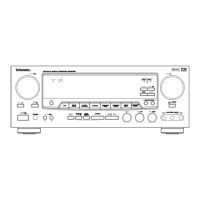- 20 -
SURROUND EFFECTS
Speaker Positioning
This installation positions of speakers differ according to
the size, and acoustics of the listening room. While
actually listening to a program source, try various
speaker positions to determine which layout provides
the best surround effect.
Speaker layout example when using SURROUND
MODE
Front speakers : Place to the front left and right of the
listening position. Front speakers are
required for all surround modes.
Center speaker : Place directly above or below the
television. This speaker stabilizes the
sound image and helps recreate
sound motion. Be sure to connect a
center speaker when using the 3
STEREO mode.
Rear speakers : Place left and right behind the
listening area.
These speakers recreate sound
motion and atmosphere. Required
for surround playback.
For best results, do not install the
rear speakers too far behind the
listening position and install them at
or above the level of the listener’s
ears. It is also effective to direct the
rear speakers towards a wall or
ceiling to further disperse the
sound.
Subwoofer : Reproduces powerful deep bass
sounds. A Subwoofer is not required
but may be added as an option.
Front Speakers
Center Speaker
Subwoofer
Rear Speakers
Speaker Configuration
It is important to perform speaker configuration prior to
using the decoder. This allows the unit to sense the
available speakers and automatically select decoding
modes. It is possible to receive multi-channel surround
sound without a center speaker, but for best results with
DTS, Dolby Pro Logic and Dolby Digital decoding, at least 5
speakers (Left, Center, Right, Left Rear and Right Rear)
should be used.
1. Each press of the SPEAKER CONFIGURATION
button will change the desired Speaker Configuration
shown on the display. (ex.: “F-LARGE”, “F-SMALL”,
“C-LARGE”, “C-NONE”, “S-LARGE” etc.)
2. Use the ADJUST ( ) buttons to set the appropriate
status.
CENTER SPEAKER Mode
- LARGE : Use this mode with a large center speaker.
The center channel’s output is full range.
- SMALL : Use this mode with a small center speaker.
- NONE : Use this mode if there is no center speaker.
The center channel signal will be divided between
the front L and R speakers.
REAR (SURROUND) SPEAKER Mode
- LARGE : Choose if a large speaker is used or if a
subwoofer is connected in parallel.
The rear channels output will be full range.
- SMALL : Choose if small speakers are used.
When using small speakers, it is recommened that a
powered Subwoofer be added to play low frequencies.
FRONT SPEAKER Mode
- LARGE : Choose if large speakers are installed.
Front channel output will be full range.
- SMALL : Choose if compact speakers are used.
Note : When LFE/Bass Out is set for FRONT, the
front channels full range is output to the front
speakers even if the front speaker mode is set to
SMALL.
a. When in DTS/Dolby Digital Mode,
Choose from:
Front Speaker : LARGE SMALL
Center Speaker : LARGE SMALL NONE
Rear Speaker : LARGE SMALL
POWER ON
(OPTIONAL)

